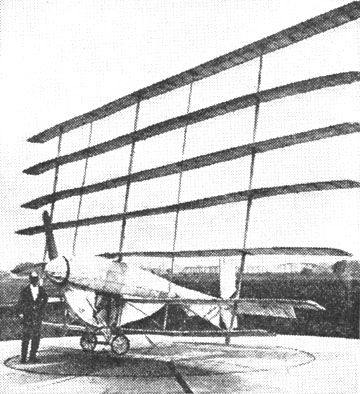|
||||||||||
|
|
||||||||||
|
||||||||||
|
|
||||||||||

The Cycloplane was built in 1923 by W. Frederick Gerhardt and E. L. Pratt of Dayton, Ohio. Gerhardt was an aeronautical engineer at nearby McCook Field. Their rickety contraption featured seven wings (a septi-plane, I suppose) of 40 ft (12.2 m) wingspan but only 18 inch (46 cm) chord. Not only were the wings themselves very thin, but the sparse bracing used to support them resulted in a very weak structure. Note how wavy the wings are in the above image.
The entire machine stood 19 ft (5.8 m) tall, but was not powered by a traditional piston engine. The craft was
instead human-powered with the pilot using bicycle pedals to spin the single propeller and produce thrust.
Although Gerhardt claimed that the Cycloplane flew on 22 July 1923, thereby becoming the first successful
human-powered aircraft, his claim could not be proven. Interestingly enough, Gerhardt was finally able to stake
his claim to human-powered flight in 1936. His Gyro-Cycle, basically a two-bladed rotor with a bicycle suspended
underneath, became airborne under the pedalling power of Johanna de Tuscon, an Olympic fencer.
- answer by Jeff Scott, 15 April 2001
Related Topics:
Read More Articles:


|
Aircraft | Design | Ask Us | Shop | Search |

|
|
| About Us | Contact Us | Copyright © 1997-2023 | |||
|
|
|||